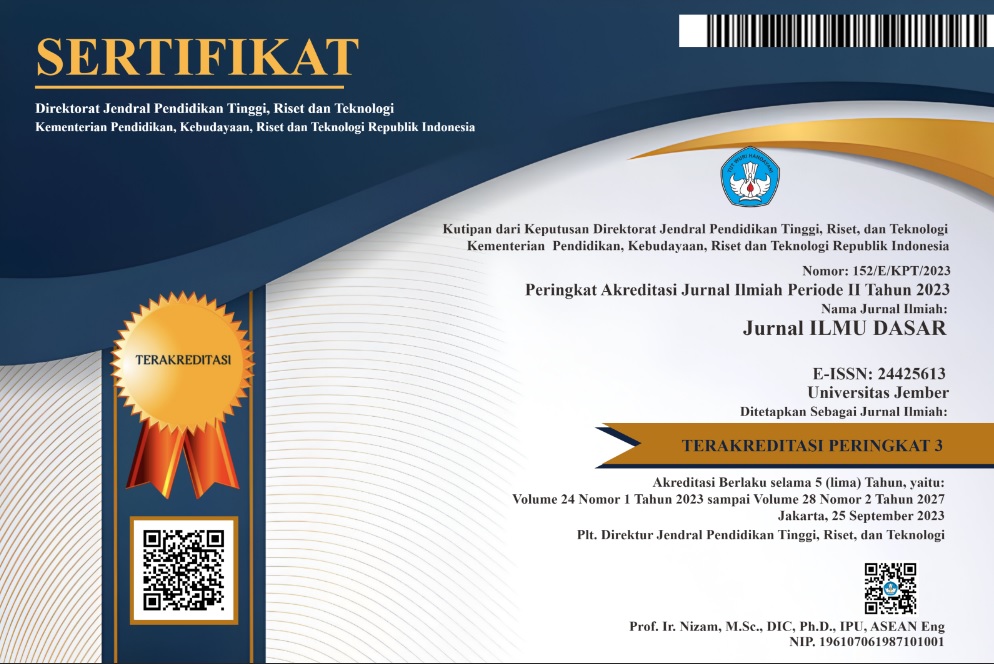Value at Risk with Performing Exponential Generalized Autoregressive Conditional Heteroscedasticity–Generalized Pareto Distribution
DOI:
https://doi.org/10.19184/jid.v23i1.18822Keywords:
asymmetric effect, value at risk, EGARCH, extreme data, generalized Pareto distributionAbstract
Stocks are an investment that many investors are interested in but often have a high risk. Value at Risk (VaR) is one tool that is often used in risk measurement. In general, financial data fluctuate rapidly so that the variants of the residuals are not constant or heteroscedasticity. The condition of heteroscedasticity is modeled using the ARCH/GARCH model. If there is an asymmetric effect on the data, it is modeled using an asymmetric GARCH model, namely Exponential GARCH (EGARCH). In addition to the impacts of heteroscedasticity and asymmetric events, extreme events in fat distribution tails are modeled using the Extreme Value Theory method, namely the Peaks Over Threshold method with the Generalized Pareto Distribution (GPD) approach. The data in this study is the return data of PT. Indocement Tunggal Prakarsa Tbk (INTP) for the period of March 1, 2013 - October 31, 2018. It was found that the data was heteroscedasticity, asymmetric, and there were also fat distribution tails, so it was modeled using a combination of EGARCH-GPD models. ARIMA ([2], 0, [2,13]) EGARCH (1,1) has the smallest AIC compared to other models, and then we choose it as the best model. The amount of risk with a 95% confidence level obtained with the GPD approach is 0.333% of current investment.
Downloads
References
Bollerslev, T. (1986). Generalized Autoregressive Conditional Heteroskedasticity. 31:307-327.
Brook, C. (2008). Introductory Econometrics for Finance (2nd ed.). Cambridge University Press.
Desi, Y. S. W., & Sutikno, S. (2013). Estimasi Parameter Generalized Pareto Distribution Pada Kasus Identifikasi Perubahan Iklim di Sentra Produksi Padi Jawa Timur. Jurnal Sains dan Seni Pomits. 2(2): 141-146.
Dharmawan, K. (2012). Menggunakan Peak-Over Threshold dan Block. 2(2): 1-12.
Dowd, K. (2002). An Introduction to Market Risk Measurement (1st ed.). John Wiley & Sons, Inc.
Engle, R. F. (1982). Autoregressive Conditional Heteroscedasticity with Estimates of the Variance of United Kingdom Inflation. Econometrica. 50(4): 987-1008.
Gilli, M., & Këllezi, E. (2006). An Application of Extreme Value Theory For Measuring Financial Risk. Computational Economics, 27(2-3): 207–228.
Lim, C. M., & Sek, S. K. (2013). Comparing the Performances of GARCH-type Models in Capturing The Stock Market Volatility in Malaysia. Procedia Economics and Finance. 5(13): 478-487.
Louangrath, P. I. (2016). Stock Price Analysis Under Extreme Value Theory. SSRN Electronic Journal. 1(4): 51-67.
Maruddani, D. A. I. (2019). Value at Risk untuk Pengukuran Risiko Investasi Saham: Aplikasi dengan Program R (T. W. Publish (ed.); 1st ed.). WADE Group Publishing.
Maruddani, D. A. I., & Trimono, T. (2020). Microsoft Excel untuk Pengukuran Value at Risk: Aplikasi pada Risiko Investasi Saham (T. U. Press (ed.); 1st ed.). Undip Press.
Morgan, J. P. (1996). Risk Metrics: Technical Document (4th ed.). Morgan Guaranty Trust Company.
Nelson, D. B. (1991). Conditional Heteroskedasticity in Asset Return: A New Approach. Econometrica. 59(2): 357-370.
Rosadi, D. (2012). Ekonometrika & Analisis Waktu terapan dengan Eviews (1st ed.). Andi Offset.
Rosso, G. (2015). Extreme Value Theory for Time Series using Peak-Over-Threshold method. ArXiv Preprint ArXiv:1509.01051. 0(9): 1-4.
Singh, A. K., Allen, D.E., & Powell, R. J. (2011). Value at Risk estimation using Extreme Value Theory. MODSIM 2011 - 19th International Congress on Modelling and Simulation - Sustaining Our Future: Understanding and Living with Uncertainty, 500(December): 1478–1484.
Tsay, R. S. (2002). Analsis of Financial Time Series. John Wiley & Sons, Inc.
Tyas, M. D. P., Maruddani, D. A. I., & Rahmawati, R. (2019). Perhitungan Value At Risk Dengan Pendekatan Threshold Autoregressive Conditional Heteroscedasticity-Generalized Extreme Value. Media Statistika. 12(1): 73.
Uminingsih, D. (2012) Model Exponential Generalized Autoregressive Conditional Heteroscedasticity (EGARCH) dan Penerapannya pada Data Indeks Harga Saham (Studi Kasus pada Saham PT. ANTAM (Persero) Tbk). Universitas Negeri Yogyakarta.
Wei, W. W. S. (2006). Tme Series Analysis, Univariate and Multivariate Methods. Addison Wesley Publishing Company.
Zuhara, U., Akbar, M. S., & Haryono, H. (2012). Penggunaan Metode VaR (Value at Risk) dalam Analisis Risiko Investasi Saham dengan Pendekatan Generalized Pareto Distribution (GPD). Jurnal Sains Dan Seni ITS. 1(1): 56-61.








